If you’re a fan of lemon desserts, you’ll love this easy recipe for homemade lemon curd. It’s perfect for filling cakes, cupcakes, and tart shells, or just spreading on toast. Plus, it’s really easy to make – you just need a few simple ingredients!
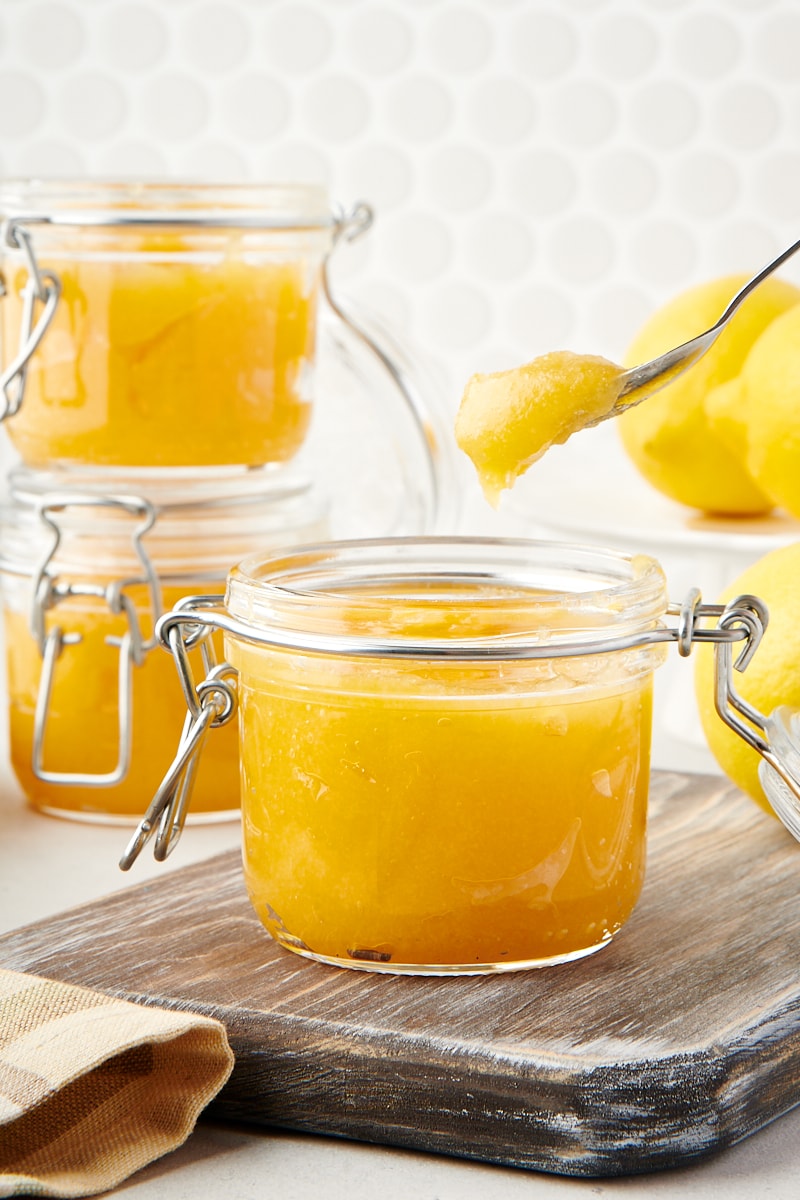
Homemade Lemon Curd
If you love all things lemon, then you’re likely already familiar with lemon curd and its intense lemon flavor. But have you ever made it yourself? Let me tell you, it’s so easy and so amazingly good!
While I certainly won’t shun store-bought lemon curd as a shortcut ingredient, I definitely prefer this homemade version. If you’ve ever wanted to try making it yourself, this is a great recipe to try as it’s simple and straightforward. Your lemon-loving taste buds will thank you!
What is Lemon Curd?
Lemon curd is a sweetened lemon spread or sauce that is typically made with lemon juice, butter, sugar, and eggs. Unlike other fruit spreads, it has a custard-like texture, thanks to the butter and eggs. While lemon curd can be store-bought, it is also surprisingly easy to make at home.
This particular recipe is my favorite for making lemon curd. I like that it can be made on the stovetop with a more traditional method or in the microwave for a quicker, easier take.
Uses for Lemon Curd
Lemon curd is a delicious and versatile spread that can be used in a variety of ways. A simple way to enjoy it is to spread it on toast or scones. Try it on waffles or muffins, too! It also makes a great filling for cakes, pies, and cookies. (Try Lemon Yogurt Crumb Cake, Ginger Lemon Hand Pies, or Lemon Thumbprint Cookies!) Or simply use it as a topping for ice cream or yogurt. If you’re a fan of all things lemon, I’m sure you’ll find all sorts of ways to put your homemade lemon curd to good use!
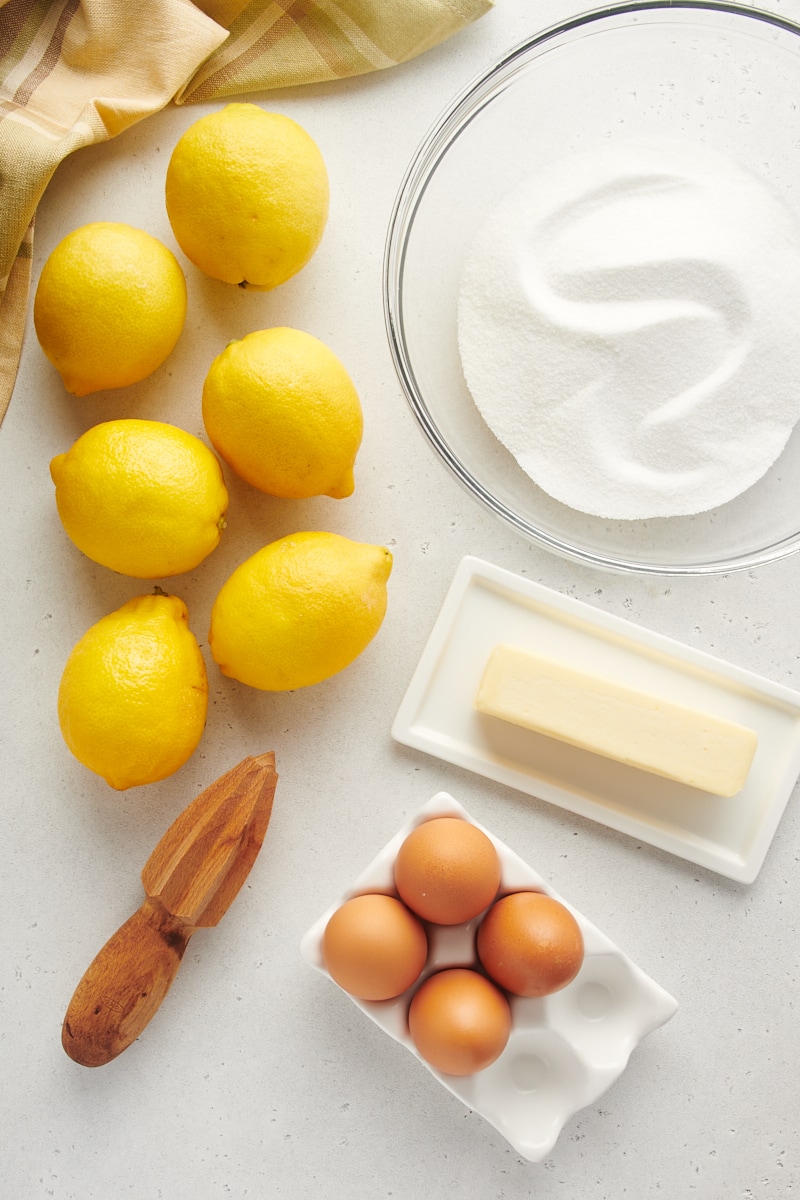
Ingredients
You only need four ingredients to make this simple lemon curd. Here are some notes about the ingredients, but be sure to see the recipe below for the specifics.
- Lemons – You’ll need about 6 medium lemons for this recipe. See my notes below about choosing the best lemons to make curd.
- Unsalted butter – The butter adds wonderful flavor and texture to the curd, so be sure to use one of good quality.
- Granulated sugar – If you want a less sweet, more lemony curd, you can dial the amount of sugar back a bit. Keep in mind that less sugar can make your curd more likely to be lumpy.
- Eggs – Some recipes for lemon curd use a different ratio of egg yolks and egg whites, but we’re keeping things simple with whole eggs.
What Kind of Lemons Make the Best Curd?
While any lemon can be used to make curd, there are certain varieties that are particularly well suited for this purpose. Eureka lemons are a good option, as they have a strong lemon aroma and are relatively easy to find. Lisbon lemons are also a good choice with their strong lemon aroma and flavor.
Meyer lemons also make excellent curd, although they are not widely available year-round. Their sweet and floral flavor makes for a little different lemon curd experience. These lemons are less acidic than other lemon varieties, which results in a smoother and more balanced curd.
For the best flavor, look for lemons that are fragrant and have thin skins. Another important tip is to look for unwaxed lemons as you’ll be using the zest. If you’re unable to find unwaxed varieties, you can try scrubbing the lemons well to try to remove as much of that wax as possible.
No matter which type of lemon you choose, you’re sure to end up with a delicious and tangy curd!

How to Make Lemon Curd
This recipe for lemon curd can be made either on the stovetop or in the microwave. Either way, the mixing portion is the same, so just choose whichever method you prefer.
Zest and juice the lemons. You’ll need a total of 2 tablespoons of zest and 1 cup of juice. Learn more: How to Zest and Juice Lemons
Begin mixing. With an electric mixer on medium speed, beat the butter and sugar until the mixture is fluffy and lightened in color. Add the eggs one at a time, mixing well after adding each one.
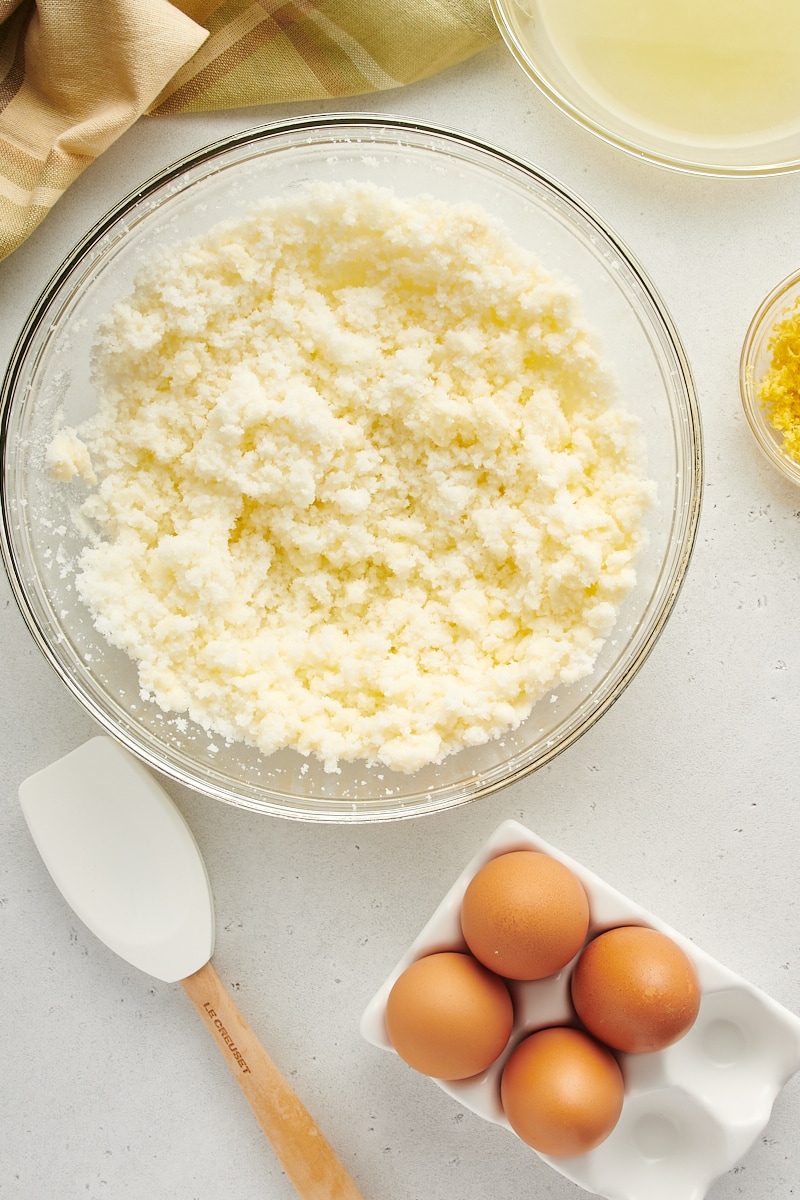
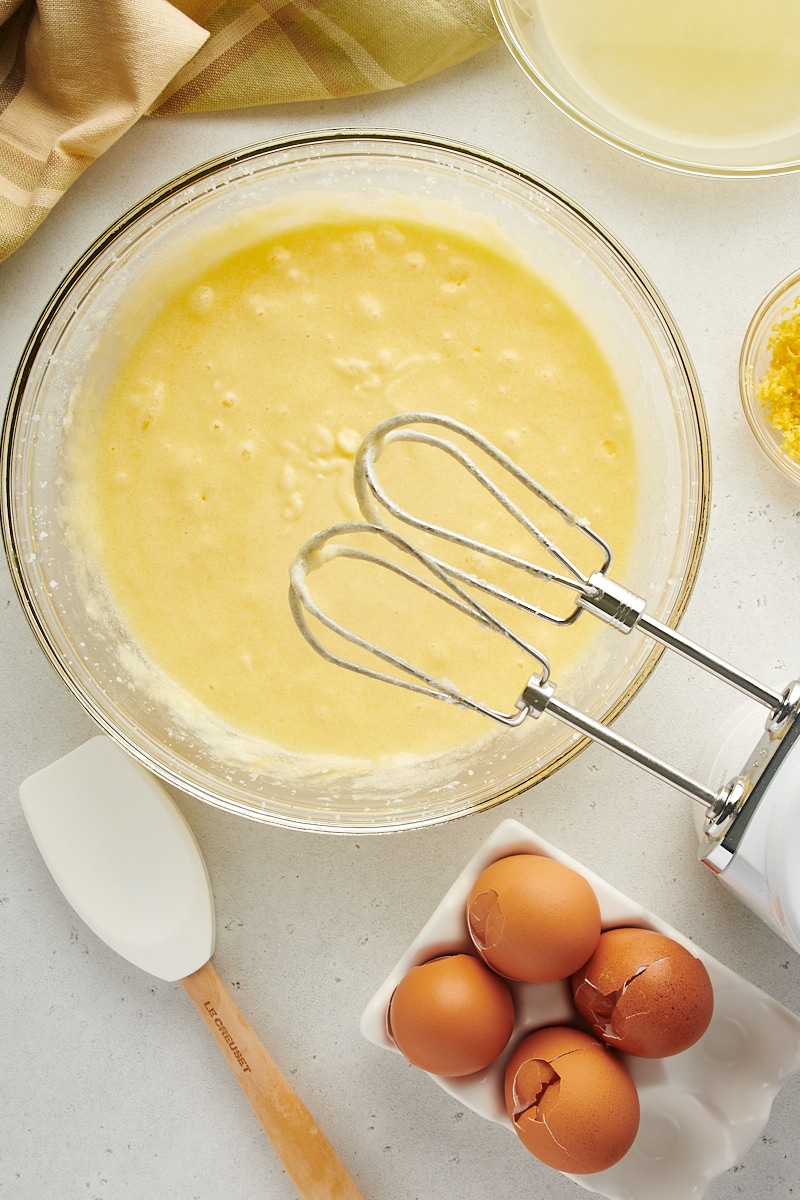
Finish mixing. With the mixer on low speed, gradually add the lemon juice. Mix just until combined. Stir in the lemon zest. At this point, the mixture will look curdled.

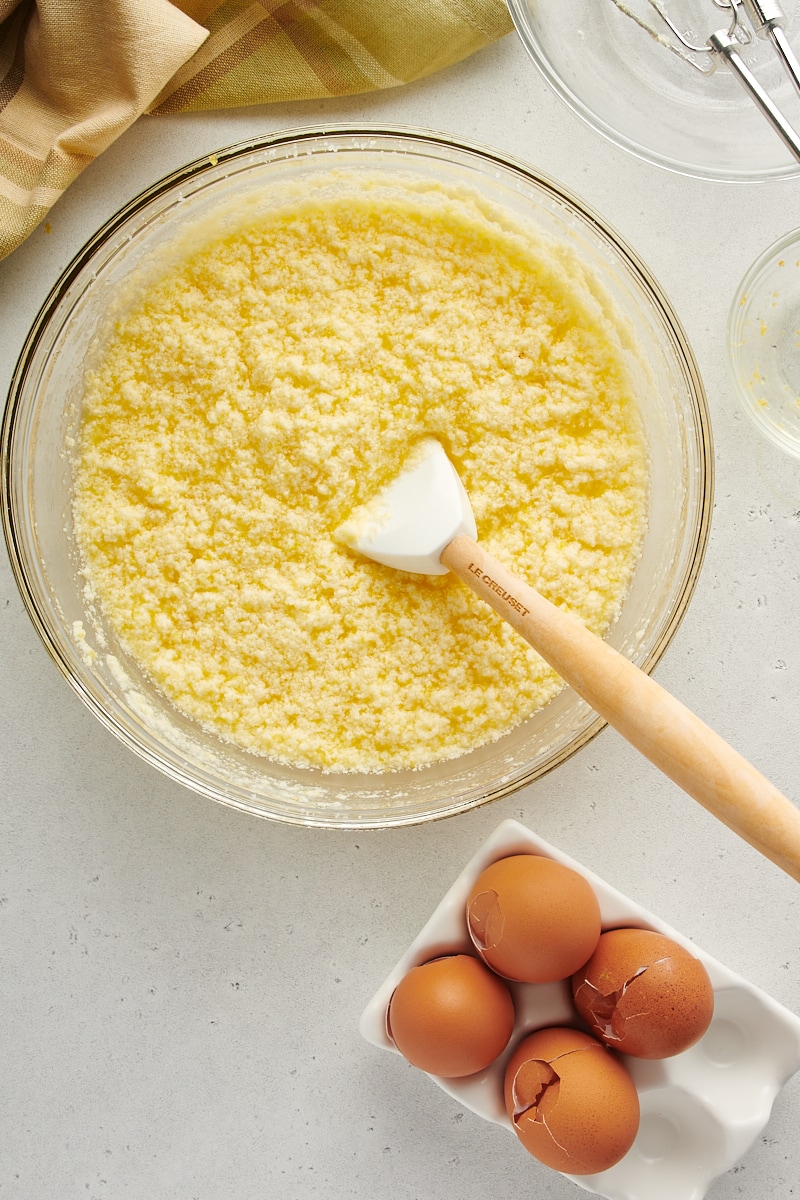
Cook. Use one of the methods described below to cook the curd until thickened. Remember that it will thicken as it cools.
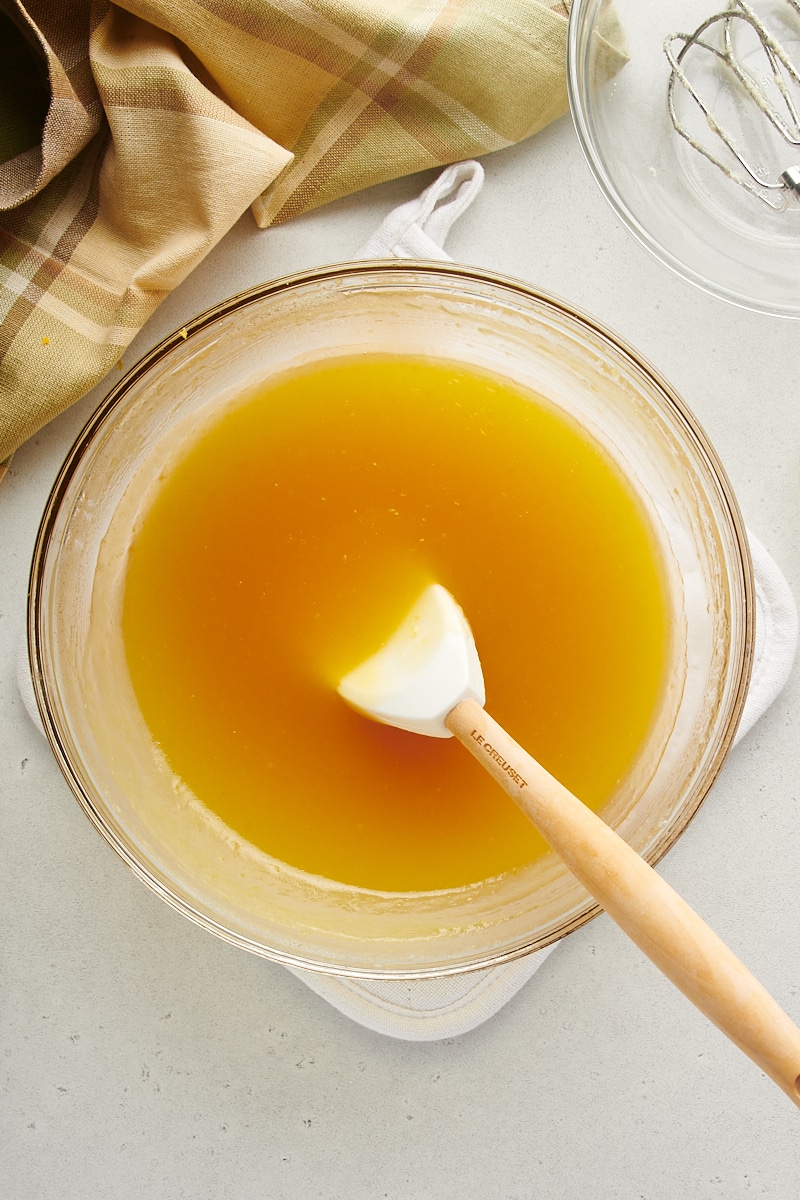
Chill. If you used the stovetop method, transfer the curd to a bowl. Place plastic wrap directly onto the surface of the curd, covering well. Refrigerate for at least 4 hours. If you like, you can transfer the curd to individual jars for storage or gifting.
Lemon Curd Microwave Method
Microwave the mixture on high speed for 5 minutes, stirring every minute. (Be sure you’re using a large microwave-safe bowl.) Continue heating in 30-second intervals, stirring after each interval for another 2-3 minutes until the mixture thickens and coats the back of a spoon. It should start to mound slightly as it’s stirred.
Keep in mind that all microwaves are different, so it may take more or less time to get the curd to the right consistency.
Lemon Curd Stovetop Method
Place the mixture in a heavy saucepan. Cook over medium-low heat, whisking constantly. The temperature shouldn’t be so high that the mixture bubbles. Continue cooking and whisking until the mixture thickens and coats the back of a spoon. This will likely take 10 to 15 minutes. If you have a candy thermometer, you can check the curd for doneness. It should reach 170 to 180°F.
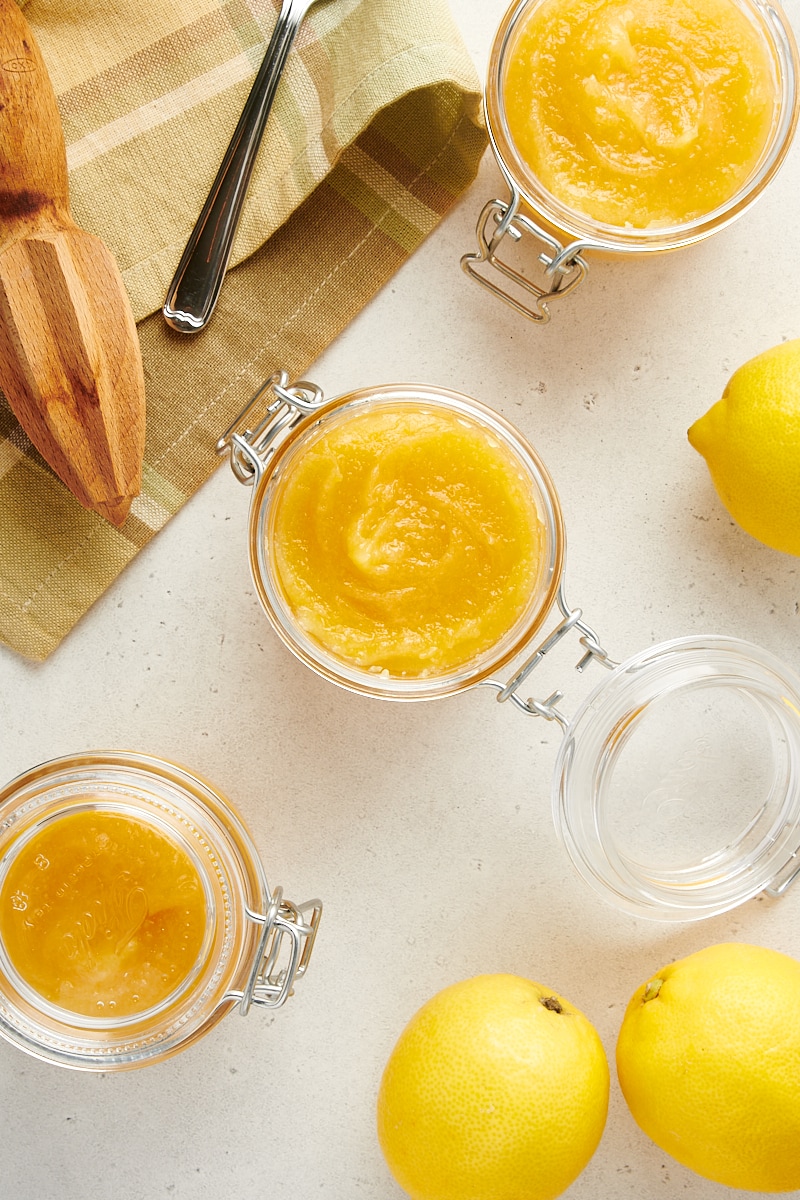
Tips for Success
- Use fresh lemon juice. It may be tempting to use bottled lemon juice, but you’ll be far happier with the results you’ll get from using fresh lemons.
- Don’t skip the zest. You’ll get a better lemon flavor and prettier color with the zest. Be sure to zest only the outside rind and not the pith underneath. I recommend a fine grater like a microplane to get very small pieces of zest.
- Try other citrus fruits. Lime, orange, and grapefruit will all make delicious curds, too!
How to Store
Lemon curd should keep up to 2 weeks in an airtight container in the refrigerator.
Can Lemon Curd Be Frozen?
Yes! Place the curd in a freezer-safe container and press a layer of plastic wrap on top before sealing. Leave about 1/4 inch or so of space at the top to allow for any expansion as it freezes. Properly stored, it will keep for several months, maybe even a year! Thaw it overnight in the refrigerator.
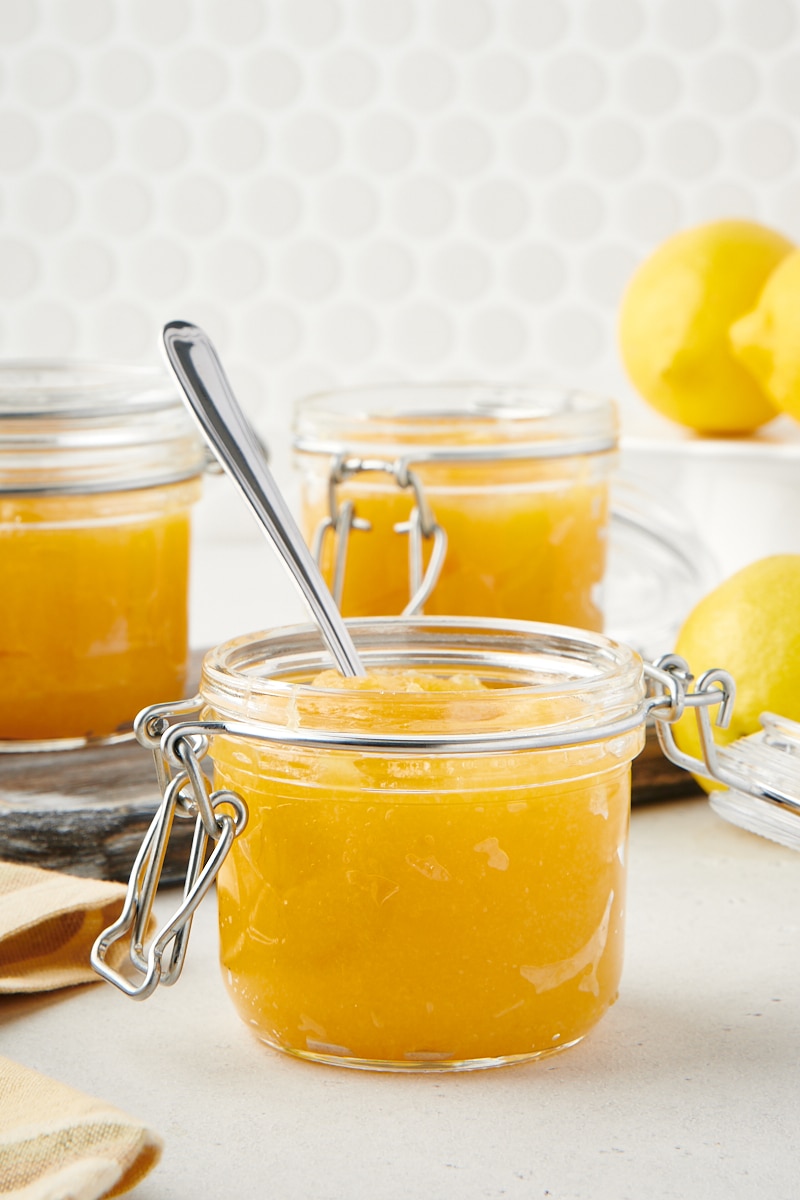
Frequently Asked Questions
Some people swear that a double-boiler is a must for making lemon curd on the stovetop, but I don’t find that to be true as long as it is cooked over the appropriate heat and whisked regularly. That being said, it’s still a consideration, especially if your stovetop’s temperature is a bit unreliable.
If you find that you need or want to use a double-boiler, be sure to use a glass or non-reactive metal bowl for the curd. Place it over a pot with a couple of inches of simmering water. Make sure the bowl with the curd mixture doesn’t touch the simmering water in the pot below. Then, cook as directed in the recipe. You may also need to add a few minutes to the expected cooking time.
This one is a maybe. Straining the lemon curd serves a couple of purposes. First, it will catch any seeds that may have made it into your mixture. Secondly, it will remove any bits of egg that may have scrambled a bit while cooking.
Straining will also remove at least some of the bigger bits of lemon zest. That can be good or bad, depending on your preferences.
If you want or need to strain your lemon curd, use a fine mesh sieve.
When lemon curd is ready to remove from the heat, it will be thickened and smooth. It should coat the back of a spoon, and leave a trail if you run your finger through the curd on the spoon. Think of it like a pudding that’s more pourable. If your curd is thick but not as thick as it should be, keep cooking.
If it still won’t thicken at all, this can be due to mis-measuring ingredients. Most likely, something may be off with the amount of lemon juice or eggs. You can try whisking some of the mixture with another egg yolk and then slowly whisking that into the mixture. Cook a bit longer, and it should thicken.
It likely didn’t cook long enough. You can try returning it to the heat and continue cooking it. Or just embrace that you made a nice lemon sauce!
Lumpy lemon curd is most likely a result of cooking it at a too high temperature. To fix this, you can remove it from the heat, whisk it really well to make it smooth, strain it, and then continue cooking. Instead of that vigorous whisking, you can try giving it a spin in your blender or using an immersion blender.
Lemons can react with some metals, giving your curd a slight metallic taste. If you’re cooking the curd on the stovetop, be sure to use a non-reactive pan to avoid this. A stainless steel or glass bowl works well.
Absolutely. Lemon curd that has been over-cooked will be lumpy, curdled, and have a pronounced egg flavor. You can attempt to rescue it as described above for lumpy lemon curd.

Lemon Curd
Homemade Lemon Curd is simple to make and so versatile. Use it for everything from a dessert filling to a simple topping.
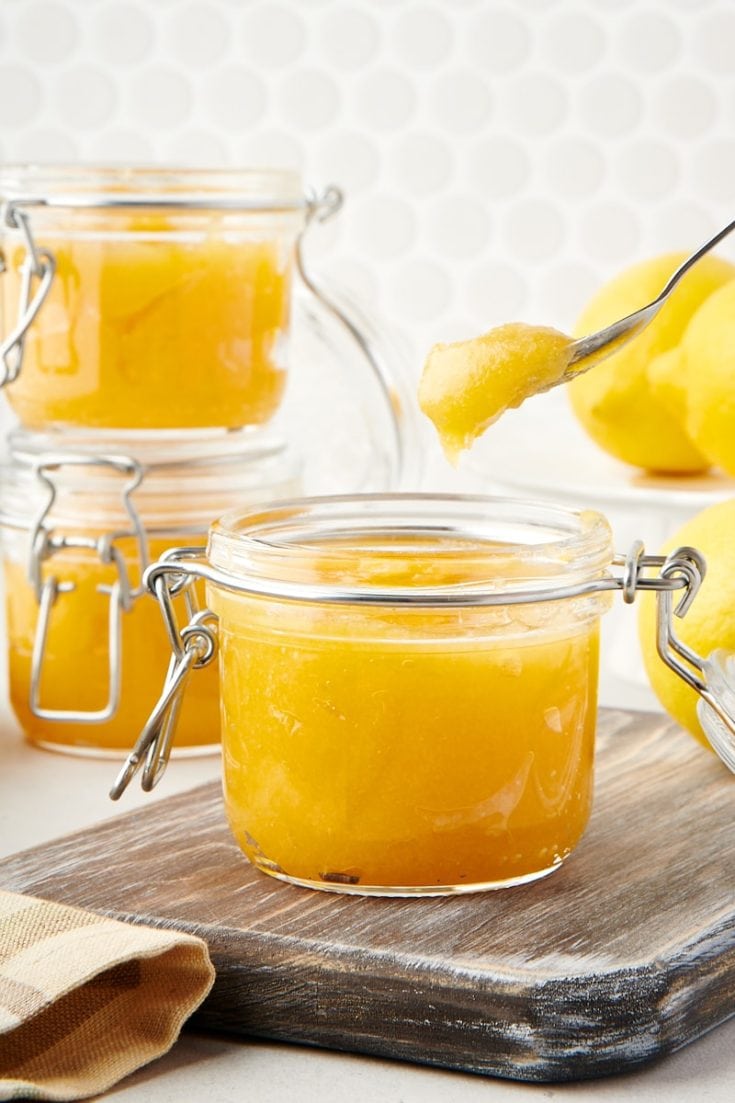
Ingredients
- 6 medium lemons
- 1/2 cup unsalted butter, softened
- 2 cups granulated sugar
- 4 large eggs
Instructions
- Zest the lemons for a total of 2 tablespoons of zest.
- Juice the lemons for a total of 1 cup of juice.
- Using an electric mixer on medium speed, beat the butter and sugar until light and fluffy. Add the eggs, one at a time, beating until blended after each addition.
- Reduce mixer speed to low. Gradually add the lemon juice, mixing just until blended. Stir in the lemon zest. The mixture will look curdled.
- To make on the stovetop: Place the mixture in a heavy saucepan. Cook over medium-low to medium heat, whisking constantly. Cook until the mixture thickens and coats the back of a spoon. This should take 15 to 20 minutes.
- To make in the microwave: Place the mixture in large microwave-safe bowl. Heat in the microwave on high for 5 minutes, stirring after every minute. Continue heating in 30-second intervals, stirring after each, for another 2-3 minutes until the mixture thickens and coats the back of the spoon.*
- Transfer the mixture to a bowl. Cover with plastic wrap, placing the wrap directly onto the surface of the lemon curd. Chill at least 4 hours.
- Store refrigerated up to 2 weeks in an airtight container.
Notes
*Microwaves vary greatly, so your cooking time may also.
Recipe adapted from Southern Living.
Recommended Products
Bake or Break is a participant in the Amazon Services LLC Associates Program, an affiliate advertising program designed to provide a means for us to earn fees by linking to Amazon.com and affiliated sites.

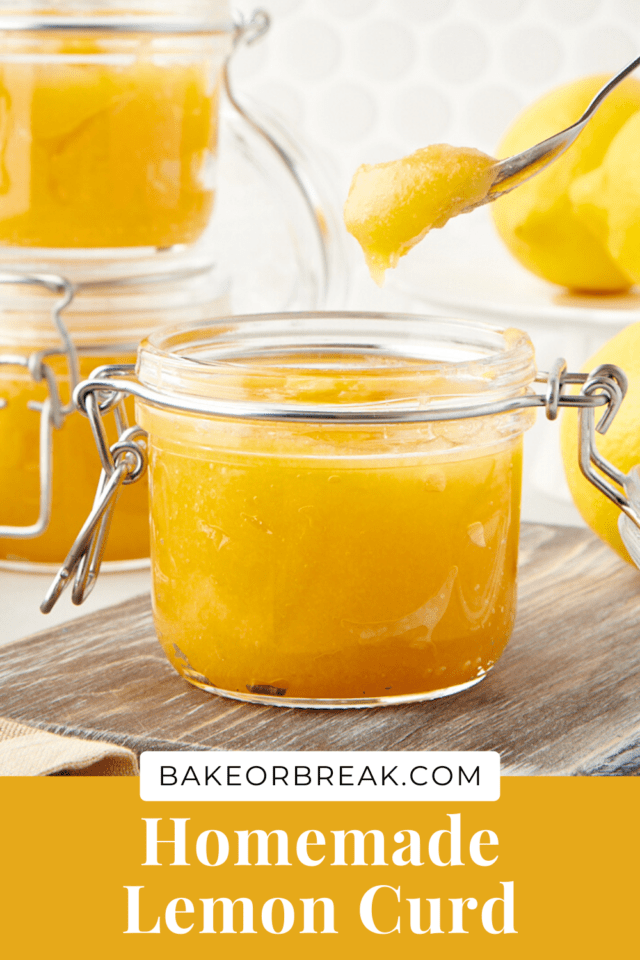

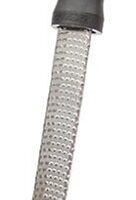



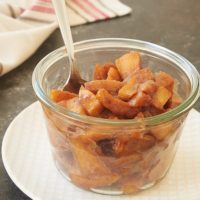
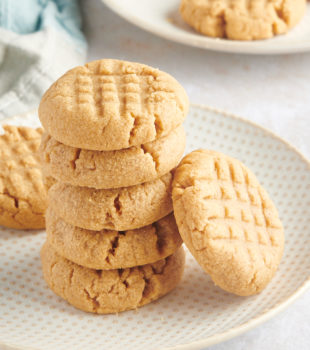





21 Comments on “Lemon Curd”
This recipe makes me smile on this winter, snowy Midwest day:)
Thanks for sharing this wonderful recipe! I was so happy to see your post—right after I baked some English scones! 🙂 Lemon curd is the perfect accompaniment! I included a link to this recipe in my blog, and I look forward to trying it! 🙂
I too am commenting from the Midwest. This is a must try recipe. Since I was a little girl, I enjoyed watching my grandmother making this and a plain cheesecake. When all was cooled, she piled the lemon curd on top of the cheese cake then decorated with a few slices of lemons. Slice and pass the whipped cream. Delish. We never got the recipe and now I can make it myself. I’m from the south where we all love our lemon anything.
Would this work for lemon meringue pie filling?
Confession: I’ve never made lemon meringue pie! You can definitely use lemon curd as a pie filling for a pre-baked pie shell. Because lemon meringue pie is cooked with the filling, I would guess that you would need to prepare it differently.
We LOVE lemon curd! I have a jar in my pantry at all times, and there is one sitting in there now :). I really want to make my own soon…we put it over toast, yogurt, scones, even ice cream :). Anything goes with sweet, tangy lemon curd. Thanks for sharing!
Hello Jennifer,
There is an even easier way to cook lemon (or any other) curd:
Mix all ingredients in a microwavable bowl and microwave on MEDIUM for about 10 minutes, checking after every 2 minutes, or until curd has thickened. Easy-peasy!
Hi, Ingrid! I debated trying this out in the microwave, but I decided to go the stovetop route this time. I’ll have to try the microwave method next time.
I adore lemon curd! Especially when slathered between the layers of a cake…
Aaaaaaaand now I want cake.
I’ve been seeing this one or a similar one where it eliminates the problem of cooking the egg whites when tossing the eggs straight into the pot instead of the mixing. I haven’t tried it but did manage to buy the lemons (both Meyer and regular) to try it. Thanks for nudging me a bit more before those lemons are too far gone. I adore homemade lemon curd. I will buy for a quick recipe where the lemon curd is IN something but when it is the star–homemade is definitely the best. Nothing bought tastes as good!
Homemade lemon curd is totally worth the bit of extra time it takes to make it!
Being the lemon lover that I am, lemon curd is one of my favorite things. I usually make it around Christmas time, but you’re making me want to make another batch (as my stash is already gone)!
Hey – regarding comment that lemon meringue pie is cooked with the filling. It isn’t, actually. The meringue is piled on top of the pie and just in oven long enough to brown the meringue. The pie filling is not baked as part of the process – unless there’s another way of doing it that I don’t know about.
I think my hubby would leave me if someone would offer him a good lemon pie. He really doesn’t care for meringue, so just make the lemon curd and put it in a pre-cooked pie shell and let him have it..so now I may be able to keep him for a while longer…LOL…
What do you think about making a bigger batch and freezing the lemon curd for later use? How do you recommend doing that, And for how long is it good to be frozen? Thanks. Looks yummy!
I’ve never frozen lemon curd, but everything I’ve read says that it freezes well for up to a year. Just thaw it for a day in your refrigerator, and it should be good for about a week afterwards.
i Jennifer first of all I love every recipe of yours than I have made. Including this lemon curd which I have made for your lemon cream pie recipe, so very good! My question is that I have a large surplus of lemons and would like to make the lemon curd to give as gifts, would it be okay to prepare the recipe in a triple amount or a bit more? Thank you
Hi, Meg. I’ve not tried scaling it, but I don’t think it would be an issue.
The lemon curd was scrumptious. I made it to go with your lemon cake recipe. If I had known the lemon curd would be so delicious I would have made a full batch! Thank you so very much for sharing.
I’m so glad you liked it, Erin!
KARISHMA. I freeze lemon curd every year. It keeps well without any degradation in texture, flavor, or color. I prefer curd with Meyer lemons, so I have to use them up when in season. I have also frozen the lemons whole.